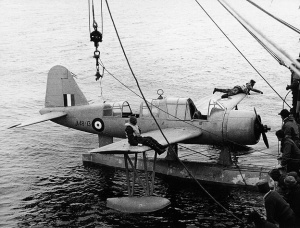The Vought OS2U Kingfisher was a United States built observation float-plane designed to be catapulted from its larger ships (i.e. cruisers and battleships). The first Kingfisher flew in March 1938 and by the end of World War II over 1,500 had been produced. Despite its under-powered Pratt & Whitney 450 hp engine the aircraft was popular due to its rugged construction.
In April 1942 The Royal Australian Air Force (RAAF) obtained 18 Kingfishers from an unexpected source. These aircraft had been destined for the Royal Netherlands Air Force, for operation in the Netherlands East Indies, but following the capture of that area by the Japanese in March 1942 the crated aircraft were diverted to Australia. The Kingfishers were allocated to 107 Squadron and operated from RAAF Base Rathmines on the Australian east coast conducting anti-submarine patrols and seaplane flight training duties. At wars end the remaining nine aircraft were flown to the RAAF Base at Lake Boga, Victoria for storage.
In late 1947 Kingfisher A18-13 was allocated to the RAAF Antarctic Flight for embarkation in the expedition vessel HMAS Wyatt Earp that was to conduct an expedition to the Antarctic in 1948. The aircraft was flown from Lake Boga to Point Cook, Victoria where a pre-heater for the engine was fitted and it was painted yellow overall. During 17-18 December 1947 the Kingfisher was embarked in Wyatt Earp then alongside at Nelson Pier in Williamstown, Victoria. An eyewitness report stated – ‘While we were in Melbourne the aircraft was placed on board. It was a monoplane with a large single float mounted below the fuselage. In its assembled form it stood too high to be safely transported on deck, so it was dismounted from the float and the aircraft and float were stowed in separate cradles on the (forward) deck’. The pilot, Squadron Leader Robin Henry Gray, DFC and aircraft fitter Flight-Sergeant Norman ‘Spike’ Jones were embarked to operate the aircraft.
Wyatt Earp sailed on 19 December 1947 bound for Hobart on the first leg of her journey to the Antarctic. The ship arrived in Hobart on 22 December and after topping up fuel and supplies sailed on the 26th. Bad weather was encountered as she headed south and the ship’s hull damaged forcing her to return to Williamstown on 7 January 1948 for repairs. The Kingfisher was craned off and temporarily returned to Point Cook. Repairs were completed in early February and the Kingfisher was re-embarked. Wyatt Earp sailed again on 8 February 1948, headed south and on the 18th the first icebergs were sighted at 65 degrees south of the Equator. Attempts to reach Commonwealth Bay failed due to pack ice reaching out 30 miles from the coast.
In 21 February the Kingfisher was prepared for flight which required much effort to attach her large central float. This was completed after five hours of hard work and she was now stored on deck ready for use. The chief scientist on board lamented the effort required and later reported – ‘I made a mistake in selecting this type of aircraft for this ship, as she is far too big for us to handle comfortably. What is needed is a small aircraft that can be kept ready for flight at short notice’. The other issue with the aircraft was starting the engine in such cold conditions and it was not until 26/27 February that the engine was able to be started after operating the pre-heater for 24 hours.
Finally while operating off the Ninnis Tongue Glacier on 13 March 1948 the Kingfisher was craned off in calm water and conducted its test flight with Flight-Sergeant Jones as the first passenger. On the second flight that day the expedition photographer, Laurie le Guay, was embarked. The aircraft radio communications system was tested and worked well and sightings of thick icebergs and pack ice for many miles was noted. Again the ships embarked scientists agreed that while an aircraft was required for Antarctic research the Kingfisher was too large and cumbersome for use from a vessel the size of Wyatt Earp.
Wyatt Earp then headed north to Macquarie Island arriving there on 20 March where she rendezvoused with LST 3510 before returning to Melbourne on 31 March 1948. The Kingfisher was disembarked on arrival and returned to RAAF Base Point Cook soon after. This aircraft was returned to storage and sold in January 1953.
Specifications
 |
| Type |
Spotter/Reconnaissance Seaplane |
|---|---|
| Length |
33 ft 10 in (10.31 m) |
| Height |
15 ft 1.5 in (4.61 m) |
| Wingspan |
35 ft 11 in (10.95 m) |
| Weights |
|
| Speed | 164 mph (264 km/h) |
| Range |
805 mi (1,296 km) |
| Altitude | 13,000 ft (3,960 m) |
| Crew |
2, pilot and observer |
| Engines | 1 x Pratt & Whitney R-985-AN-2 radial engine, 450 hp (336 kW) |
| Armament |
Guns: 2 x .30 in (7.62 mm) M1919 Browning machine guns (one on flexible mount for observer). Bombs:650 lb (295 kg) of bombs. |
| Ships embarked in | HMAS Wyatt Earp |
